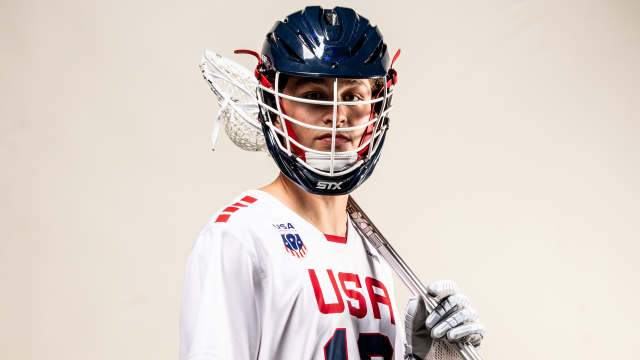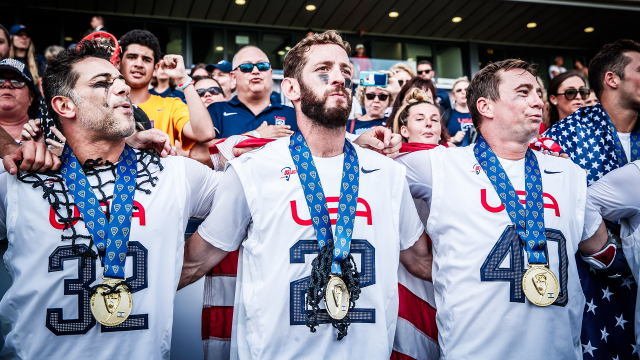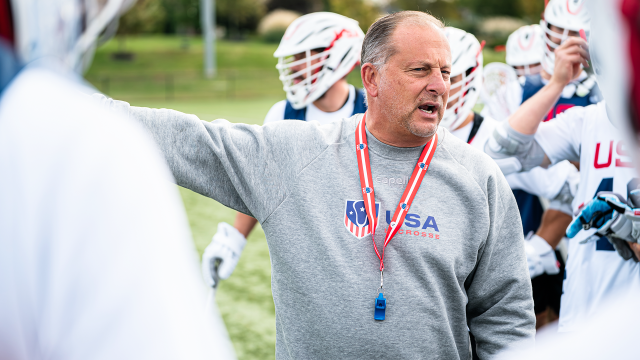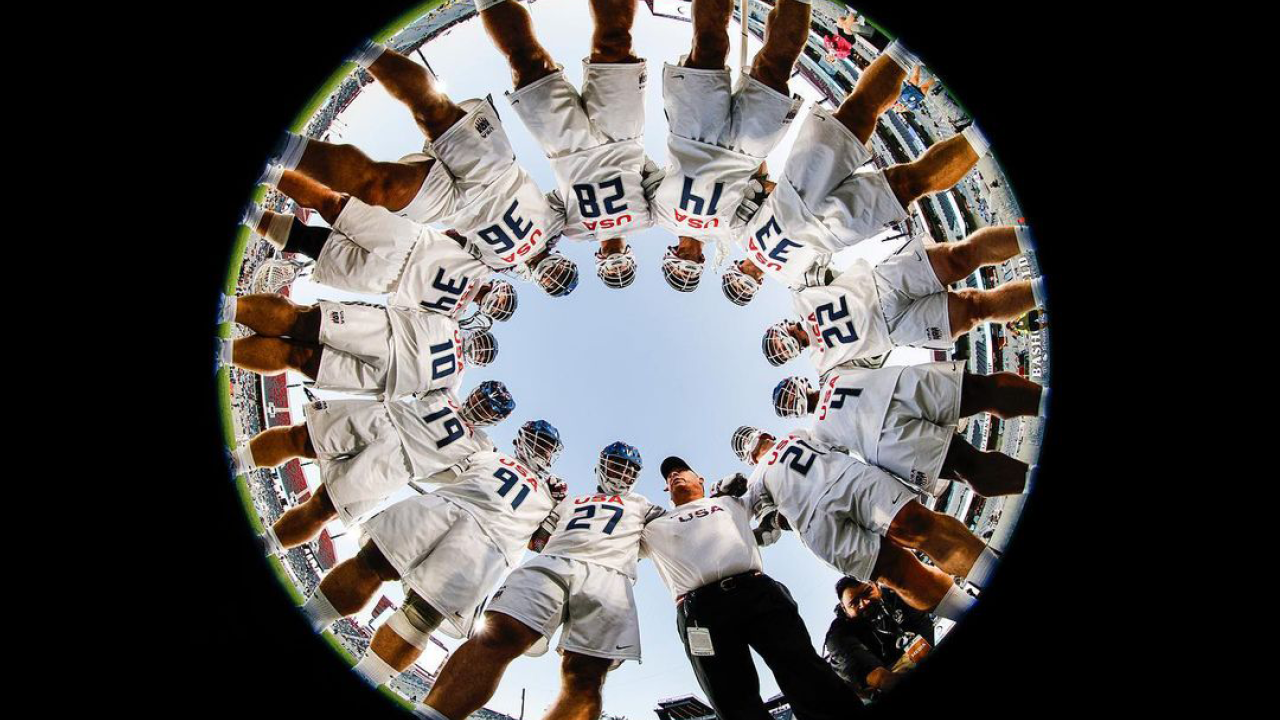
Best Defense Ever Played? USA Makes Case with Historic Dominance
SAN DIEGO — When World Lacrosse announced in June 2020 that the World Lacrosse Men’s Championship would be pushed back from 2022 to 2023 due to the pandemic, it provided a pair of blessings in disguise for the U.S. men’s national team.
First, it gave Brennan O’Neill another year to mature. Look how that turned out.
Second, it allowed the coaches to learn and leverage virtual teambuilding. Video conferencing became so ubiquitous in both business and sports that even late adopters embraced it as a tool they would keep even after the public health emergency ended.
Head coach John Danowski (Duke) and assistants Joe Amplo (Navy), Seth Tierney (Hofstra) and Charley Toomey (Loyola) all experienced establishing a team culture and identity over Zoom. They had no choice. College fall ball was largely nonexistent in 2020, and many teams operated in pods through the 2021 season.
They brought that experience to the U.S. team. Amplo and Toomey used weekly Zoom meetings to align philosophically a defensive unit that could have comprised an All-World team on its own.
Players downloaded Optimize. Developed by philosopher and CEO Brian Johnson, the app distills for users the central concepts from best-selling books on culture and leadership into consumable text and audio files. Each week, two players chose a subject, discussed it independently of the group and then presented together what they learned about themselves and each other within the context of the reading.
The conversation inevitably got personal, as veteran defenseman Jesse Bernhardt’s thoughts turned to his late father and short-stick defensive midfielder Danny Logan’s to his late uncle — an NFL coach and former four-time Olympic hammer thrower, respectively.
Goalie Jack Kelly talked about how he thought his lacrosse career was over the moment he went down with an ACL injury in the 2018 world championship and how he derived inspiration from his brother, Dylan, a Navy pilot and officer currently working on the USS Nimitz.
“I wanted these guys to dig down into their hearts and souls and be uncomfortable with conversations that men don’t usually have,” Amplo said. “The opponents’ pieces, they’re high end. They’re as good as you can create. We have to out-team them on our end of field. We worked since January connecting on a human level.”
The result? Maybe the best defense ever played.
If that sounds hyperbolic, consider that of the 28 goals the U.S. allowed in seven games (team-record 4.0 goals per game), just 19 (or 2.7 GPG) were scored playing six-on-six in the box. Eighty-six of opponents’ 105 possessions resulted in defensive stops, a success rate of 81.9 percent (defensive efficiency 18.1 percent).
For a comparative reference, Lacrosse Reference founder Zack Capozzi compiled the defensive efficiencies of every NCAA Division I men’s lacrosse team from 2016-19 — the last four seasons before the shot clock, which does not exist in the international game — and assigned them to a scale where 100 was the average. Richmond’s 2017 season (78.8 percent success rate) topped the list with a 146 rating.
“Using the same scale,” Capozzi explained, “Team USA just put up a 171 rating.”
Consider also that the Americans were without 2018 world championship MVP Michael Ehrhardt and glue guy Matt Dunn for much of the tournament due to injuries. They did not skip a beat.
All-World defenseman JT Giles-Harris limited All-World attackman Jeff Teat to just three assists in two games against Canada and kept Lyle Thompson scoreless when the two matched up in the Haudenosaunee game.
Bernhardt’s timely slides and double-teams resulted in a team-high 10 caused turnovers. The 32-year-old defenseman and three-time U.S. team member missed the birth of his son to play in the games and emerged as the group’s unequivocal leader.
Jack Rowlett toggled between Dunn and Ehrhardt’s spots at close defense and long-stick midfield, snagging the most ground balls (12) of any position player and causing seven turnovers while not getting flagged for a single penalty.
When they did play, Ehrhardt helped jumpstart a stagnant offense with a pair of long-pole rips and Dunn blanked Canada’s Curtis Dickson, a historically difficult matchup for the U.S.
The rope unit was as good as advertised. Liam Byrnes and Zach Goodrich’s wing play helped faceoff specialists Trevor Baptiste and TD Ierlan combine for an astounding 80.3-percent showing at the X.
The least decorated of the four short-stick defensive midfielders, Jake Richard led the unit both by voice and example. Logan and Richard blunted dodgers with brute force, at times, while Ryan Terefenko ignited transition and notably eluded an ambush of Canadians in the final moments of the 10-7 U.S. win in the gold medal game.
“The short-stick d-middies are elite,” Danowski said. “It’s like dodging poles.”
There was, simply, not a single weak link among the 10 defenders. And when there was the rare breakdown, the goalies came through, including All-World selection Blaze Riorden’s eight-save performance in the final. No one wanted to be the player responsible for a letdown.
“That’s what we said, best defense in the world,” Logan said. “Working toward this goal over so many months — phone calls, Zoom calls, fighting through injuries — coming together as a group was the most special experience of my life.”
Asked to characterize the U.S. defense, Bernhardt chose two words: selfless and connected.
“It was about picking the right guys,” Bernhardt said. “Obviously a ton of talented dudes out there, but the ability to have guys in and out throughout the tournament — that’s just a testament to the unit and the connectivity.”
Matt DaSilva
Matt DaSilva is the editor in chief of USA Lacrosse Magazine. He played LSM at Sachem (N.Y.) and for the club team at Delaware. Somewhere on the dark web resides a GIF of him getting beat for the game-winning goal in the 2002 NCLL final.
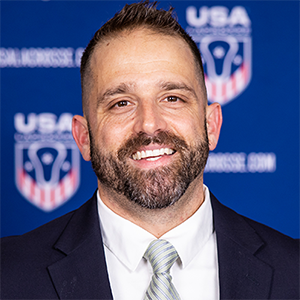
Categories
Related Articles
